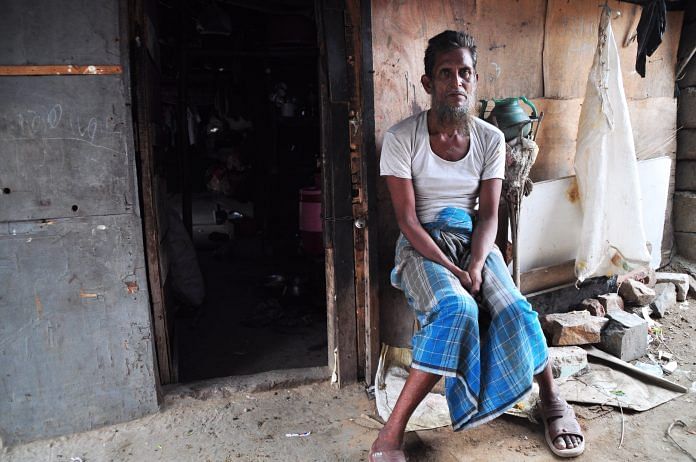India, struggling with the issue of Rohingya Muslim refugees, has granted asylum to displaced people from Tibet, Afghanistan, Pakistan among others.
New Delhi: The Global Trends report released Tuesday — marked as World Refugee Day — by the United Nations High Commission for Refugees said the global forcibly displaced population touched 68.5 million in 2017, up by 2.9 million from the year before.
The report said 25.4 million refugees fled their country last year, with four out of five moving to a country bordering theirs.
Syrian refugees made up for the highest proportion of the displaced people. As of 2017, there were 12.6 million forcibly displaced Syrians, with 6.3 million refugees, 146,700 asylum-seekers and 6.2 million internally displaced persons. Syrians have spilled over into 125 countries, with the highest number being hosted by Turkey.
The other countries with a high number of displaced population are the Afghans, Sudanese, Somalians and Congolese.
In India’s neighbourhood, the biggest refugee problem was of the Rohingyas — more than 18,000 have moved into India from Myanmar. The total number of Rohingyas, mostly Muslims, who fled their homes are 7,00,000.
The refugees have been housed in poorly facilitated camps across the country even as India is trying to deport them. It has also spoken against Myanmar at the UN General Assembly, urging them to solve their internal problems and take back their citizens.
As the issue of refugees rages on worldwide, here’s a look at why World Refugee Day is imperative.
World Refugee Day
During the Second World War, thousands of Europeans were displaced and in dire need of security, food and shelter. After the fall of League of Nations, the need for an international body catering solely to the needs of refugees was felt. This led to the formation of Article 14 of the Universal Declaration of Human Rights in the Geneva Convention of 1951. Amended in 1967, this Article defines a refugee as:
“Someone who has been forced to flee his or her country because of persecution, war, or violence. A refugee has a well-founded fear of persecution for reasons of race, religion, nationality, political opinion or membership in a particular social group. Most likely, they cannot return home or are afraid to do so.”
In 2001, on the 50th anniversary of the Geneva Convention, it was decided that 20 June would be observed as International World Refugee Day, in recognition of the millions of people who lost their homes and livelihoods to war and disasters.
The main objective behind the World Refugee Day is to increase awareness regarding the condition of the refugees.
The UNHCR is the main authority on issues related to refugees.
How India looks at refugees
According to the UNHCR report released Tuesday, India is home to 1,97,146 refugees of which 27,299 are assisted. Another 10,519 asylum seekers are in line to get their pending requests cleared.
India has so far granted asylum to displaced people from Tibet, Myanmar, Afghanistan, Pakistan, Sri Lanka, Somalia and Bangladesh.
However, the most peculiar aspect to India’s stance on refugees is the lack of a solid protection framework. India is not a signatory to the 1951 Refugee Convention, but generally respects the principle of non-refoulement for holders of UNHCR documentation. The policy of non-refoulement means the state will refuse to send refugees back to a place where they face a threat to their life.
As soon as refugees enter Indian territory, they are bound by Indian laws and enjoy the liberties enshrined under the Constitution, including the right to life and personal freedom. Most high courts in India have adopted the rules of natural justice to refugee issues. They also enjoy the right to practice their own religion and culture.
The Indian unit of the UNHCR works in collaboration with the ministry of external affairs and the ministry of home affairs. Its main task is to help refugees with rehabilitation, healthcare, security and education. All of this is done with the assistance of funding raised by the Indian government and the UN offices.
The history of refugees in India
India is home to refugees from 28-odd countries. The first group of refugees that came to free India was from Pakistan in the immediate aftermath of Partition. For a nation so young, this influx of refugees was a huge issue, and their rehabilitation an added burden.
In 1959, Tibet’s head of state Dalai Lama had to flee from his homeland with some 1,00,000 followers, and they came to India seeking refuge. The Indian government welcomed them, a move that has become a permanent thorn in Indo-China relations.
In 1971, after war broke out between East and West Pakistan, a large population of erstwhile East Pakistan fled to India seeking shelter and security. The huge influx of Bangladeshi refugees led to a change in demographic composition of the northeastern states, which resulted in persistent community conflicts.
In 1979, after the Soviet invasion of Afghanistan, India became an option for Afghan refugees. They kept coming in small numbers and were able to integrate themselves in North India. According to an UNHCR report, India has more than 200,000 Afghans.
From 1983 to 1987, Sri Lankan Tamils came to India in three waves. The weight of this huge influx of Sri Lankan Tamils was borne primarily by Tamil Nadu.






